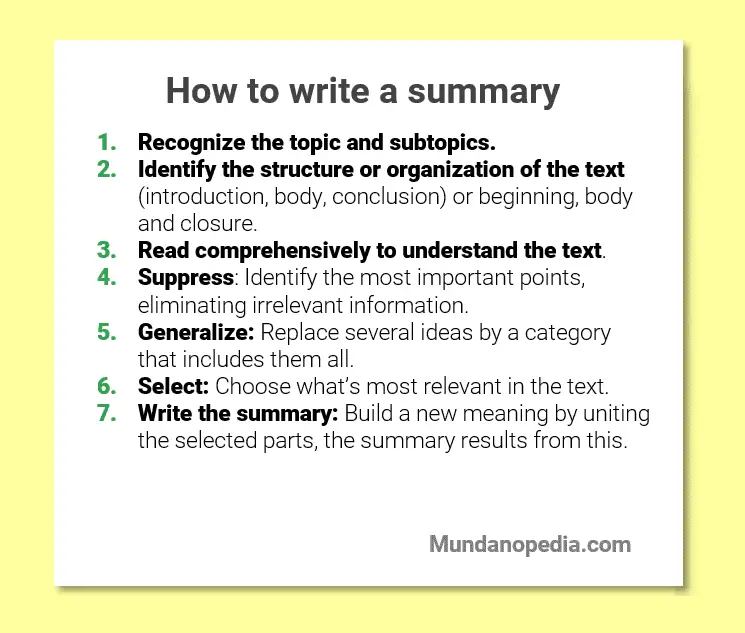How to Write a Summary: Step-by-Step Guide with Examples

What is a summary
A summary is the reduction of a text to its minimum expression as a result of a complex act of comprehension, through which the essence or most important aspect of a topic is captured in a few words and in a simple way.
But a summary is not just cutting and pasting what is considered important, because the reduction of the text results from a cognitive process, from criticism. The summary is the result of the comprehensive reading of the topic.
Here you will learn how to write a summary.
Functions of a summary
The function of a summary is to support readers, since it allows them to remember relevant information and process knowledge more quickly. It also serves as a support or guide for other things, such as providing information in a practical and fast way. This is the case of some books or academic papers, where a summary is presented at the beginning so the possible reader can decide whether to read it or not.
Steps to write a summary
To make write summary, you must follow the following steps:
- Recognize the topic and sub-themes.
- Identify the structure or organization of the text (introduction, body, conclusion) or beginning, body and closure.
- Read comprehensively and understand the text.
- Suppress: Identify the most important points, eliminating irrelevant information.
- Generalize: Replace several ideas by a category that includes them all.
- Select: Choose what most represents relevance in the text.
- Write the summary: Build a new meaning by uniting the selected parts, the summary results from this.
Reading comprehensively
A summary is the result of complex thought processes through comprehensive reading, therefore, in order to make a summary, one should not read superficially, but rather pay attention to the text that is intended to be summarized. You must apply each of the stages of comprehensive reading: Pre-reading, through-reading and post-reading.
Strategies for reading comprehension
These strategies are actions carried out to understand what is read, reaching deep levels of comprehension. (1)
- Inferences. Inferences consist of reaching conclusions based on premises (2). The reader forms ideas that are not explicitly in the text, but he/she creates in his/her mind by combining them with previous experiences and knowledge.
- Anticipations. It’s to anticipate and create possible contents according to what is read.
- Conclusions. It’s the manifestation of the final results once reading is over.
- Generalizations. It consists of extracting the particular characteristics of the text, what is common to all, and issuing globalizing propositions.
- Paraphrase. It consists of explaining in your own words what you read.
See also: Reading comprehension: Concept, Phases, Levels, & Strategies
Rules to write a summary
A summary has four fundamental rules and they are the following:
The suppression rule
It consists of suppressing or eliminating the complementary elements of the text.
The rule of generalization
It consists of replacing several ideas with a category that includes all of them, for example, instead of saying “teachers, directors, and administrative staff do their job,” it says that “school staff do their job.”
Selection rule
It consists of choosing keywords from a text or those that represent relevance to the text and to the reader.
The construction rule
It consists of replacing the meaning, or possible meanings, of the text by a new construction.
Example of a summary
Text | Literal summary | Paraphrase summary | Interpretive summary |
Writing means producing a specific communicative writing. In this sense, when we write, we transmit knowledge, present our point of view, describe the development of a thematic, we question, request, report an event, record agreements, demand, praise, criticize, etc. Unfortunately, the traditional teaching of writing seems to ignore the true nature of written communication. | Writing is producing a specific communicative writing. For this reason, when we write we transmit knowledge, we present a point of view, we describe a subject, we ask questions, we give an account of something, we record agreements, we praise, etc. Unfortunately, the traditional teaching of writing does not seem to understand the true nature of written communication. | Writing is producing text with a specific intention. When we write, we do it because we want to communicate something, transmit knowledge, ideas, request something, clarify, support, etc. Despite this, the traditional teaching of the newsroom does not know what written communication is. | Writing is communicating ideas in writing, when we write we do it with a communicative purpose, but the traditional teaching of writing seems to ignore it |
See also